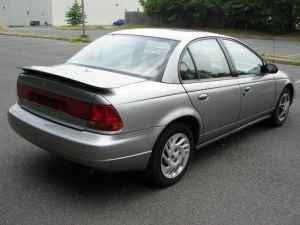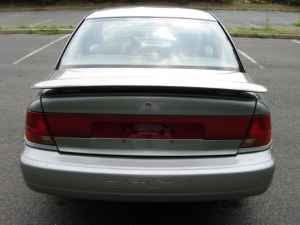


A spoiler is an automotive aerodynamic device whose intended design function is to 'spoil' unfavorable air movement across a body of a vehicle in motion. This can result in improved vehicle stability by decreasing lift, which may cause unpredictable handling in a car at high speeds. Spoilers are often fitted to race and high-performance sports cars, although they have become common on passenger vehicles, as well. Some spoilers are added to cars primarily for styling purposes and have either little aerodynamic benefit or even make the aerodynamics worse.
Spoilers for automobiles are often incorrectly confused with, or even used interchangeably with, wings. Automotive wings are devices whose intended design is to lessen the effect of drag by generating lift, or to generate downforce as air passes around them, not simply disrupt existing airflow patterns.
The main design goal of a spoiler in passenger vehicles is to reduce drag and increase fuel efficiency. While many often imitate wings and airfoils, these serve mostly decorational purposes. Passenger vehicles can be equipped with front and rear spoilers. Front spoilers, found beneath the bumper, are mainly used to direct air flow away from the tires to the underbody where the drag coefficient is less. Rear spoilers, which modify the transition in shape between the roof and the rear and the trunk and the rear, act to minimize the turbulence at the rear of the vehicle.
Sports cars are most commonly seen with front and rear spoilers. Even though these vehicles typically have a more rigid chassis and a stiffer suspension to aid in high speed maneuverability, a spoiler can still be beneficial. This is because many vehicles have a fairly steep downward angle going from the rear edge of the roof down to the trunk or tail of the car. At high speeds, air flowing across the roof tumbles over this edge, causing air flow separation. The flow of air becomes turbulent and a low-pressure zone is created, increasing drag and instability (see Bernoulli effect*, below). Adding a rear spoiler makes the air "see" a longer, gentler slope from the roof to the spoiler, which helps to delay flow separation. This decreases drag, increases fuel economy, and helps keep the rear window clean.
In nearly all cases, drag increases as the speed of the vehicle increases. Thus, some spoilers that are effective at very low speeds often generate excessive drag at high speeds, and spoilers that work well at high speeds are often ineffective while moving more slowly.
First off, there is the weight; spoilers arent weightless.
Second is drag. If you affect airflow, you generate drag. You would be amazed and disappointed at how much drag a race car has; about 4 times what a normal car has!
Third, a spoiler that generates too much downforce and/or is mounted too far back WILL remove weight from the front end. By too far back, that generally means "behind the rear axle", though proper placement may miniize this pitfall.
Fourth, you may or may not go fast enough (LEGALLY!!!) for that spoiler to work. Many spoilers don't work much/at all at any legal speed though some do.
But DAMN! They DO LOOK COOL!
*Bernoulli effect - For horizontal fluid flow, an increase in the velocity of flow will result in a decrease in the static pressure. The equation describing this effect is known as Bernoulli's law. The most practical example of this is in the action of an airfoil. The shape of an airplane wing is such that air flowing over the top of the wing must travel faster than the air flowing under the wing, and so there is less pressure on the top than on the bottom, resulting in lift.
Spoilers for automobiles are often incorrectly confused with, or even used interchangeably with, wings. Automotive wings are devices whose intended design is to lessen the effect of drag by generating lift, or to generate downforce as air passes around them, not simply disrupt existing airflow patterns.
The main design goal of a spoiler in passenger vehicles is to reduce drag and increase fuel efficiency. While many often imitate wings and airfoils, these serve mostly decorational purposes. Passenger vehicles can be equipped with front and rear spoilers. Front spoilers, found beneath the bumper, are mainly used to direct air flow away from the tires to the underbody where the drag coefficient is less. Rear spoilers, which modify the transition in shape between the roof and the rear and the trunk and the rear, act to minimize the turbulence at the rear of the vehicle.
Sports cars are most commonly seen with front and rear spoilers. Even though these vehicles typically have a more rigid chassis and a stiffer suspension to aid in high speed maneuverability, a spoiler can still be beneficial. This is because many vehicles have a fairly steep downward angle going from the rear edge of the roof down to the trunk or tail of the car. At high speeds, air flowing across the roof tumbles over this edge, causing air flow separation. The flow of air becomes turbulent and a low-pressure zone is created, increasing drag and instability (see Bernoulli effect*, below). Adding a rear spoiler makes the air "see" a longer, gentler slope from the roof to the spoiler, which helps to delay flow separation. This decreases drag, increases fuel economy, and helps keep the rear window clean.
In nearly all cases, drag increases as the speed of the vehicle increases. Thus, some spoilers that are effective at very low speeds often generate excessive drag at high speeds, and spoilers that work well at high speeds are often ineffective while moving more slowly.
First off, there is the weight; spoilers arent weightless.
Second is drag. If you affect airflow, you generate drag. You would be amazed and disappointed at how much drag a race car has; about 4 times what a normal car has!
Third, a spoiler that generates too much downforce and/or is mounted too far back WILL remove weight from the front end. By too far back, that generally means "behind the rear axle", though proper placement may miniize this pitfall.
Fourth, you may or may not go fast enough (LEGALLY!!!) for that spoiler to work. Many spoilers don't work much/at all at any legal speed though some do.
But DAMN! They DO LOOK COOL!
*Bernoulli effect - For horizontal fluid flow, an increase in the velocity of flow will result in a decrease in the static pressure. The equation describing this effect is known as Bernoulli's law. The most practical example of this is in the action of an airfoil. The shape of an airplane wing is such that air flowing over the top of the wing must travel faster than the air flowing under the wing, and so there is less pressure on the top than on the bottom, resulting in lift.

No comments:
Post a Comment